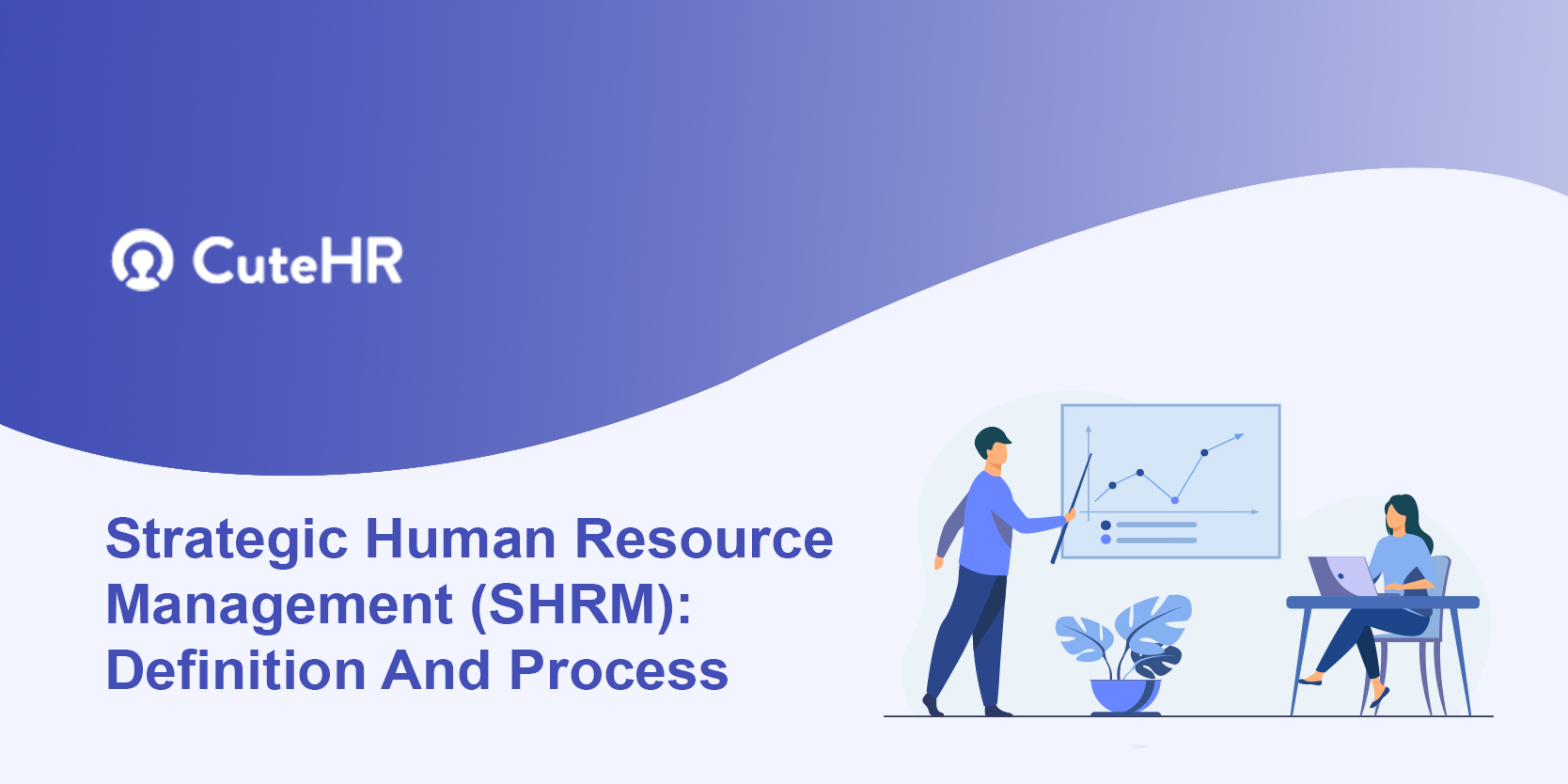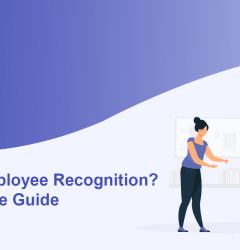09 Mar

Did you know? Salary (67%) and benefits (63%) are the most important information to job seekers. People are the most valuable assets in any business because they contribute individually and collectively to attaining goals.
But, in an era of fast change, how can you prepare for and make strategic human resource decisions that will move your business toward its objectives?
We define and explain the functions and relevance of strategic human resource management in this blog.
Table of Contents
What Is Strategic Human Resource Management?
Strategic human resource management (SHRM) is a comprehensive approach to constructing the finest staff for your company’s growth and success.
To understand strategic human resource management, you must first understand traditional human resource management. Human resource management (HRM) is the process and practice of finding, hiring, and training the best personnel for your company.
Human resource management also comprises providing your employees with the training, growth, work environment, rewards, and remuneration they need to perform at their best among their coworkers and within your firm as a whole.
Strategic human resource management elevates these tasks by employing and training personnel in accordance with the company’s goals and the vision, mission, and organizational strategies that lead them.
A human resource department working under the auspices of Strategic human resource management must, by definition, connect with other departments within your company in order to:
- Learn about their specific requirements.
- Understand their objectives and how they connect to the objectives of the firm.
- Develop hiring and retention strategies that support those goals.
- Provide those departments with the resources they require to succeed.
Strategic human resource management is a more hands-on approach to advancing your company’s interests and capabilities.
Why Is Strategic Human Resource Management Important?
Since the previous twenty years or more, there has been a growing fear of HR being isolated from business goals and functioning as a distinct component of the corporation. There was a growing need felt across industries for HR to play a critical role in enhancing productivity in firms in order to gain a competitive edge.
As a result, strategic HRM was born. The major purpose of strategic human resource management is to address corporate objectives or barriers that do not fall under the scope of HRM. This can only be accomplished through excellent human resource management. Thus, it is essentially a fine-tuning of human resource management (HRM) to meet corporate objectives. Hard HRM and Soft HRM are two different kinds of HRM.
Strategic HRM requires good collaboration between senior management and the HR head. The following are some of the issues that modern HRM faces:
- Intercultural interactions and issues
- Internationalization
- Changing ownership as a result of rising M & A
- Business settings that are rapidly evolving
- Technological progress
Objectives Of Strategic Human Resource Management
As previously said, strategic human resource management entails constructing the greatest staff for your company’s development and success. The process’s most fundamental goal is to match the appropriate individuals with the right roles in your business.
This may be done by your HR department while interviewing prospective employees or even during a performance review of a long-term team member who is seeking additional responsibility.
Objectives of Strategic human resource management are as follows:-
- Predicting career and skill changes
- Implementing a successful onboarding process
- Adapting to rapid technological advancements
- Enhancing business operations
- Preventing talent shortage or surplus
- Adjusting to a more globalized economy
- Preparing for generational and cultural shifts
- Observing local, state, and federal regulations
- Advancing product innovation
- promoting development
- Risk reduction
As you can see, SHMR is critical to the successful functioning of your business and its long-term growth.
Because this process is intertwined with every element of your organization, the notion of developing a new SHRM strategy may overwhelm you.
Don’t let this prevent you from using a system that has the potential to alter the way your organization runs now and in the future.
Remember that strategic human resource management does not have to meet all of the objectives on this list from the start. Begin small and gradually extend into new locations once you’ve completed one or two objectives.
Elements of Strategic Human Resource Management
Strategic human resource management pillars are as follows:
a) Humans are more than simply resources; they are an asset to an organization that should give it a competitive advantage.
b) It is the individuals within the organization that are in charge of implementing such transformation.
c) Every change is only possible with effective planning and execution in accordance with the organizational demands and objectives.
d) The primary goal of strategic HRM is to focus on ways for the company to get a competitive advantage.
e) Strategic human resource management, according to Hendry and Pettigrew, has four distinct meanings, namely:
- Making use of planning.
- Designing and managing people consistently.
- Creating systems based on employment policy and workforce strategy.
- Coordination of HR operations and other policies in the development of corporate strategy.
- Seeing people as resources and gaining a competitive advantage by making the most of them.
Aspects of Strategic human resource management to consider
The aspects of successful SHRM implementation are numerous. The root problem is a lack of or failure to adopt a growth plan. Other key impediments are described below:
- Instilling the transformation effort’s vision and mission.
- High resistance as a result of the bottom line’s unwillingness to cooperate.
- Interdepartmental conflict.
- The entire senior management team’s dedication.
- It is necessary to have a varied workforce with competitive skill sets.
- There is a dread of being victimized in the aftermath of failures.
- Inadequate strategic assignments and leadership power struggles
- Consequences for power dynamics
- The entire senior management team’s dedication.
- Plans that integrate internal and external resources.
- Time, money, and resources are all limited.
- Employees’ adherence to the status quo.
- Concerns about senior management’s unwillingness to pursue strategic initiatives.
- Legislative changes make you vulnerable.
- The resistance is channeled through authorized labor institutions.
- The presence of an active labor union.
- Rapid structural transformations.
- Economic and commercial considerations prompted the implementation of strategic human resource management.
- A more varied, outward-looking strategy is preferred.
SHRM Vs. HRP Vs. Organizational Strategy
Before we get into the nuts and bolts of strategic human resource management, it’s crucial to understand where SHRM fits into the bigger picture of your company.
SHRM is a subset of the larger commercial activity known as human resources (HR). Human resources (HR) is a basic component of your organization that deals with what is, maybe, your most valuable asset: people.
Human resources encompass tasks such as human resource planning (HRP) and, at a higher level, even links into organizational strategy.
How does everything fit together to make your business successful? It is beneficial to envision diverse activities on a scale ranging from “simple” to “complicated” (or, perhaps, practical to theoretical). As we work our way up, we should begin at the bottom.
We mentioned one of the most fundamental functions of human resources earlier in this article: connecting the right person with the right position. Then we progress up the “complexity” scale to Human Resource Planning (HRP).
Human resource planning (HRP) is the continual activity of deliberately planning to optimize and maximize the hiring and retention of high-quality employees. HRP is essentially concerned with loSHRM is a holistic strategy to assembling the ideal team for your business’s growth and success, which we’ve addressed further up the human resources ladder.
At first appearance, HRP and SHRM appear to be the same activity under a different name. They appear to be so similar because one is a subset of the other.
In this scenario, HRP is a minor component of SHRM. From a different angle, SHRM contains and oversees HRP.
It’s similar to a set of nesting dolls: the smaller one (HRP) fits perfectly into the next largest (SHRM), which fits into the next largest, and so on at the hiring process as a whole and optimize the way your company matches workers to roles.
SHRM, in other words, is the why to HRP’s what.
Another approach to consider SHRM and HRP is to imagine your company as a vast, intricate machine.
HRP is one component (for example, a gear) that collaborates with other comparable components (for example, manufacturing, logistics, shipping, management, and so on) to keep the machine operating.
Strategic human resource management, on the other hand, examines the machine as a whole.
SHRM examines the performance of each component (each department in your organization), how they collaborate to keep things running smoothly, and what the business as a whole can do to improve.
Is SHRM, however, the ultimate stage in the process? Is it the driving force behind everything else? No, it isn’t. The organizational plan of your company is located above SHRM.
At its most basic, organizational strategy is a plan that defines how your company will distribute resources to support infrastructure, manufacturing, marketing, inventory, and other commercial operations.
What impact does this have on SHRM? Consider the following: SHRM is directed by organizational strategy, while HRP is directed by HRP. In many respects, your company’s strategy reflects the link between SHRM and HRP.
Corporate strategy, business strategy, and functional strategy are the three major areas of organizational strategy. Each level, like SHRM and HRP, is a subset of the one above it.
The principal aim of your business is corporate-level strategy – it is the destination toward which your organization is traveling.
The business-level strategy serves as a link between corporate-level strategy and much of the “on-the-ground” action that happens in functional-level strategy.
The precise tasks and benchmarks you allocate to departments and individuals to drive your firm toward the goals established by your corporate-level strategy are referred to as functional-level strategies. They are a direct result of your corporate-level initiatives.
With those categories in mind, you can begin to grasp the wider picture of your organization: SHRM is part of your business-level plan, whereas HRP is part of your functional-level strategy.
Strategic Human Resource Management Planning Process
1. Identify Your Business Goals
Before you can implement SHRM, you must first establish your company’s objectives.
Setting objectives, whether for increased market penetration, expansion into new markets, or a stronger bottom line, helps you to design strategies (functional, business, and corporate) to attain those goals.
With this road map in mind, your HR personnel can next begin the process of adopting strategic human resource management.
2. Assess your HR capabilities
Developing your HR expertise is critical if you want your new tactics to be successful.
Is your human resources department prepared to undertake strategic human resource management? Do the members of the team have appropriate expertise and training?
If not, you may need to make changes within the department, give on-the-job training, or acquire new employees to assist with the transition.
3. Team Evaluation
When you’ve determined where you want your company to go (by the goals and strategies you devised in step one), you can assess your current team to see how their talents contribute to the goals you’ve set.
It is also critical to select team members who are eager to learn new parts of your organization.
4. Analyze each department
Once your HR department is ready, it’s time to let them free on the other departments that make up your organization, with the objective of bringing them all into line with your goals and strategy.
The goal of this study is to identify each department’s specific needs and how HR can give the talent to boost performance to 100 percent.
5. Hire to meet departmental needs
Human Resources may begin hiring to suit the department’s requirements with the department’s needs in mind.
Some departments may require specialized abilities, but others may require team members that fit more easily into the existing corporate culture.
Your firm can recruit the best person to take it to the next level and beyond with effective human resource management.
The Challenges Of Strategic Human Resource Management
Strategic human resource management, as helpful and effective as it is, is not without its obstacles.
SHRM, first and foremost, is based on predictions. And, regardless of how much data you have or how much expertise you have in the industry, forecasting is always an imprecise art that is never 100 percent correct.
Similarly, you can never account for the market’s ups and downs, as well as the fast shift that can occur at any time without warning.
As a result, some inaccuracy will always be incorporated into your strategic human resource management. That blunder will affect the other actions in this list, for better or worse (depending on how accurate your forecast is). The key is to ensure that the good always outnumbers the negative.
Realistically, on the other hand, are unavoidable. To avoid them, you have to give it your all. If you find flaws in your forecasts, you may simply go back to step one and start over with the new information.
Other difficulties encountered throughout the strategic human resource management process include:
- A tenacious workforce
- Information systems that are inefficient
- Total cost
- Effort and time
That being said, if you are aware of the hurdles ahead of time, you may take immediate actions to overcome them, allowing you to reap the rewards sooner.
Strategic Human Resource Management: Benefits and Competitive Advantages
The most significant advantage of strategic human resource management is also its goal: to improve organizational performance by integrating and aligning with business strategy.
“Human resource management is crucial to competitive advantage.” In manufacturing companies, quality procedures rely on effective HR systems.
HR in service organizations includes training, incentives, performance management, and staff selection assistance to help businesses to give the best possible service to their clients. The Four Seasons and Hampton Inn both have quality systems based on training, support, personnel selection, and rewards,” Lambert adds.
Strategic human resource management supports the following benefits by developing processes to improve organizational performance:
- HR-Related Outcomes: Lower turnover, lower absenteeism, improved work satisfaction, and greater employee engagement
- Outcomes for the Organization: Increased productivity, quality, service, efficiency, and customer satisfaction
- Profits, sales, return on assets, and return on investment have all increased.
- Outcomes of the Capital Market: Increased market share, stock price, and growth
According to Deshler, a corporation can only achieve these benefits if its strategic human resource management coincides with its business strategy. “Strategic human resources management by itself does not provide most companies with a competitive advantage.
This is where we frequently fail. Strategic human resource management is an effective activity that is strategic when it supports the corporate strategy.
Too many HR leaders have pursued projects and HR skills that the organization did not want or require. Of course, we have good intentions when we suggest and construct strategic human resource management skills, but we must keep a close watch on how these capabilities will support business strategy,” he says.
SHRM, Scheduling, and Communication
Scheduling is an essential component of strategic human resource management. And in the twenty-first century, the finest schedules are generated with the use of specialized software such as Sling.
A sling can assist ease the schedule-creation process whether your company has one shift or three, employs flextime or a compressed workweek, or operates a 9-to-5 work schedule or a 9/80 work schedule.
Another aspect of SHRM is communication.
It makes no difference if the communication is about scheduling, inventories, clocking in and out, ethics, or customer service. The more effectively you interact with your staff, the more powerful your team will be.
Wrapping It Up
Strategic Human Resource Management encompasses a lot more than you would think. HR should not simply match its practices with the company plan; in order to be genuinely strategic, HR should understand where the strategy originates from and connect with the various stakeholders to whom the strategy is aimed.
HR will be able to bring enormous value to the business if it is successful in this endeavor.
I hope this article has provided you with a decent understanding of Strategic Human Resource Management.
Frequently Asked Question’s (FAQs)
How does HRM differ from strategic HRM?
Unlike HRM, Strategic HRM mainly focuses on programs with long-term objectives. Strategic HRM focuses on internal and external partnerships as opposed to traditional HRM on employee relations. Strategic HRM has long-term goals, unlike HRM only has short-term goals.
What are the 4 HR strategies?
External labor orientation is combined to develop the four different HR strategies, which include
- Loyal Soldier (cost leadership/internal labor)
- Bargain Labourer (cost leadership/external labor)
- Free Agent (differentiation/external labor)
- Committed Expert (differentiation/internal labor).












Himani